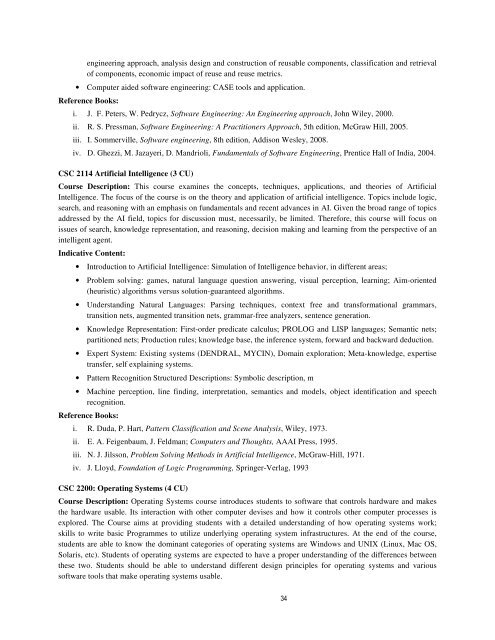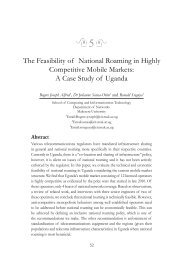Undergraduate Handbook - School of Computing and Informatics ...
Undergraduate Handbook - School of Computing and Informatics ...
Undergraduate Handbook - School of Computing and Informatics ...
You also want an ePaper? Increase the reach of your titles
YUMPU automatically turns print PDFs into web optimized ePapers that Google loves.
engineering approach, analysis design <strong>and</strong> construction <strong>of</strong> reusable components, classification <strong>and</strong> retrieval<br />
<strong>of</strong> components, economic impact <strong>of</strong> reuse <strong>and</strong> reuse metrics.<br />
• Computer aided s<strong>of</strong>tware engineering: CASE tools <strong>and</strong> application.<br />
Reference Books:<br />
i. J. F. Peters, W. Pedrycz, S<strong>of</strong>tware Engineering: An Engineering approach, John Wiley, 2000.<br />
ii. R. S. Pressman, S<strong>of</strong>tware Engineering: A Practitioners Approach, 5th edition, McGraw Hill, 2005.<br />
iii. I. Sommerville, S<strong>of</strong>tware engineering, 8th edition, Addison Wesley, 2008.<br />
iv. D. Ghezzi, M. Jazayeri, D. M<strong>and</strong>rioli, Fundamentals <strong>of</strong> S<strong>of</strong>tware Engineering, Prentice Hall <strong>of</strong> India, 2004.<br />
CSC 2114 Artificial Intelligence (3 CU)<br />
Course Description: This course examines the concepts, techniques, applications, <strong>and</strong> theories <strong>of</strong> Artificial<br />
Intelligence. The focus <strong>of</strong> the course is on the theory <strong>and</strong> application <strong>of</strong> artificial intelligence. Topics include logic,<br />
search, <strong>and</strong> reasoning with an emphasis on fundamentals <strong>and</strong> recent advances in AI. Given the broad range <strong>of</strong> topics<br />
addressed by the AI field, topics for discussion must, necessarily, be limited. Therefore, this course will focus on<br />
issues <strong>of</strong> search, knowledge representation, <strong>and</strong> reasoning, decision making <strong>and</strong> learning from the perspective <strong>of</strong> an<br />
intelligent agent.<br />
Indicative Content:<br />
• Introduction to Artificial Intelligence: Simulation <strong>of</strong> Intelligence behavior, in different areas;<br />
• Problem solving: games, natural language question answering, visual perception, learning; Aim-oriented<br />
(heuristic) algorithms versus solution-guaranteed algorithms.<br />
• Underst<strong>and</strong>ing Natural Languages: Parsing techniques, context free <strong>and</strong> transformational grammars,<br />
transition nets, augmented transition nets, grammar-free analyzers, sentence generation.<br />
• Knowledge Representation: First-order predicate calculus; PROLOG <strong>and</strong> LISP languages; Semantic nets;<br />
partitioned nets; Production rules; knowledge base, the inference system, forward <strong>and</strong> backward deduction.<br />
• Expert System: Existing systems (DENDRAL, MYCIN), Domain exploration; Meta-knowledge, expertise<br />
transfer, self explaining systems.<br />
• Pattern Recognition Structured Descriptions: Symbolic description, m<br />
• Machine perception, line finding, interpretation, semantics <strong>and</strong> models, object identification <strong>and</strong> speech<br />
recognition.<br />
Reference Books:<br />
i. R. Duda, P. Hart, Pattern Classification <strong>and</strong> Scene Analysis, Wiley, 1973.<br />
ii. E. A. Feigenbaum, J. Feldman; Computers <strong>and</strong> Thoughts, AAAI Press, 1995.<br />
iii. N. J. Jilsson, Problem Solving Methods in Artificial Intelligence, McGraw-Hill, 1971.<br />
iv. J. Lloyd, Foundation <strong>of</strong> Logic Programming, Springer-Verlag, 1993<br />
CSC 2200: Operating Systems (4 CU)<br />
Course Description: Operating Systems course introduces students to s<strong>of</strong>tware that controls hardware <strong>and</strong> makes<br />
the hardware usable. Its interaction with other computer devises <strong>and</strong> how it controls other computer processes is<br />
explored. The Course aims at providing students with a detailed underst<strong>and</strong>ing <strong>of</strong> how operating systems work;<br />
skills to write basic Programmes to utilize underlying operating system infrastructures. At the end <strong>of</strong> the course,<br />
students are able to know the dominant categories <strong>of</strong> operating systems are Windows <strong>and</strong> UNIX (Linux, Mac OS,<br />
Solaris, etc). Students <strong>of</strong> operating systems are expected to have a proper underst<strong>and</strong>ing <strong>of</strong> the differences between<br />
these two. Students should be able to underst<strong>and</strong> different design principles for operating systems <strong>and</strong> various<br />
s<strong>of</strong>tware tools that make operating systems usable.<br />
34

















